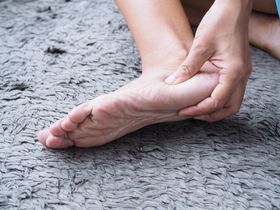Choosing the Best Running Shoes for Supinated Feet
Updated December 9, 2024.

Overpronation and supination are common foot problems experienced by athletes. While overpronation is more common, supination is no less significant in its impact on the runner. To understand foot supination, the supinated foot rolls on its outer borders during weight transfer, and with excessive supination comes pain and soreness of the leg muscles as compensatory mechanisms kick in and gait adjustment takes place.
Foot supination is the result of a muscle imbalance during foot motion. There are many causes of foot supination, including limb length discrepancy, foot width, ankle stability, the shape of the foot arch, how the shoe fits, and body malalignment.
In this guide, we discuss how supinated feet affect the body, how running with supinated feet is experienced, the type of shoe to wear as a supinator, and how to choose the best footwear for your needs.
The Impact of Supinated Feet on the Body
A foot that supinates can be a significant problem when exercising. The foot cannot adapt to the surface it's walking on, meaning that the muscles and bones have to compensate to maintain your posture and balance. The weight that should be transferred directly to the ground through the foot is reabsorbed and redistributed to the lower limb.
Over time, this increases the tension in the muscles, ligaments, and tendons of the lower limb, including the calves, knees, and hips. Consequently, more energy is expended while exercising with supinated feet.
What Type of Footwear Do Supinators Need for Running?
Interestingly, the right footwear can help correct excess supination, ensuring efficient weight transfer during running. The best footwear for supinators to wear when running has extra cushioning, good arch support, and a wide toe box. When working in combination, these features will ensure the foot derives maximal support, encourage pronation, and aid shock absorption.
How to Choose Running Shoes for Supinated Feet
When purchasing a running shoe for supinated feet, look for footwear that offers the following:
- Arch support Are you trying to decide if you need arch support? For supination, the simple answer is yes, as there are many benefits of arch support. Look for shoes with mid-foot arch support, as this compensates for excessive supination. Shoes without such arch support encourage supination and cause arch pain.
- Comfortable fit An oversized shoe increases the normal supination of the foot. Therefore, you should opt for shoes that are the right size for you, both in width and length.
- Heel cushioning A running shoe with extra cushioning at the heels will minimize the impact of the ground on your heel during a heel strike. The best cushions are soft, stable, and springy to allow for efficient energy absorption and transfer between the foot and the ground and vice versa. Thus, the heel cushioning protects the heel while you run, while guaranteeing efficient energy returns.
- Wide toe box Shoes with a narrow toe box restrict the movement of your feet and increase the likelihood of damage as a result of supination. With a wider toe box, the feet have room to spread after every stride, reducing the strain on the fascia and preventing conditions such as plantar fasciitis, which is common in people that supinate excessively.
- Ankle support and stability With increased supination, the pressure on the plantar fascia increases, leading to plantar fasciitis. To prevent this and other overuse ankle injuries, you should opt for shoes that are stable and provide extra ankle support.
- Neutral feel Cushioning or not, you still need a shoe that has the natural feel of the ground when you run. It may be necessary to ensure the shoe has a responsive cushion to ensure the feeling remains as natural as it can be with a high arch.
- Using orthotics Even if you find a shoe with all these features, a shoe alone cannot cure excessive supination. However, using the shoe in conjunction with an orthotic can be highly effective. This is especially important if you have pain while running, or your shoes do not fit correctly. Orthotics make it easier and more comfortable and pain-free to perform your activities of daily living and sport. Additionally, they help to reduce the chance of developing complications or future injuries due to the supination.
Running With Supinated Feet
Running with supinated feet places extra stress on the outer side of the foot. There will also be increased tension in the muscles, ligaments, and tendons in the lower limb as they work together to counterbalance the tension from the redistributed body weight.
To address this, running with orthotics and proper footwear helps you to control foot motion and prevent further complications. It also gives you room to continue to work towards improving your technique, so you do not supinate excessively when running.
Remember that finding the correct footwear is only one method of treating the complications of supination. Doing exercises and frequent stretches are two of the many other ways to treat excessive supination.








